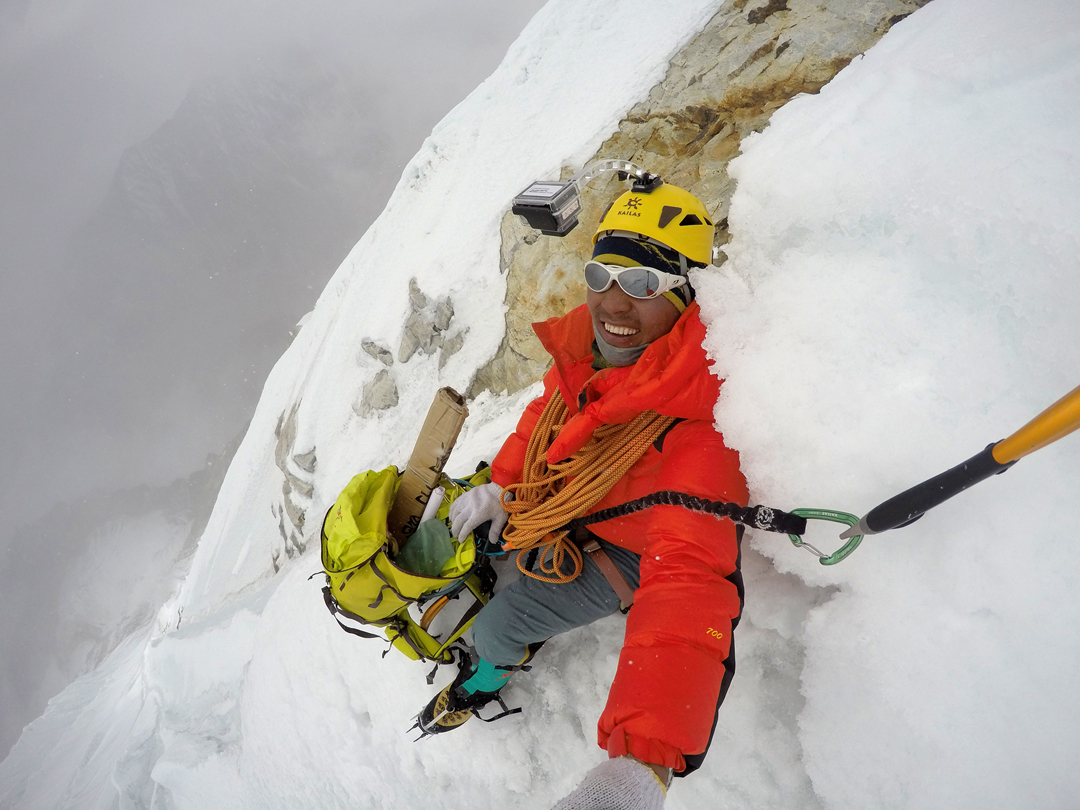Chobutse, West Face, Dorjee Sherpa Route
Nepal, Rolwaling Himal
 It took me three years to decide whether to go for a solo attempt on Chobutse (6,686m). I grew up in the Rolwaling Valley, seeing the mountain from my home. Each time I go back it seems so close and attractive, especially the west face, which remained unclimbed. In the 2014-’15 winter, I thought about trying the peak without an official permit, as it is our own domestic mountain. However, the weather turned bad and I had to cancel at the last moment.
It took me three years to decide whether to go for a solo attempt on Chobutse (6,686m). I grew up in the Rolwaling Valley, seeing the mountain from my home. Each time I go back it seems so close and attractive, especially the west face, which remained unclimbed. In the 2014-’15 winter, I thought about trying the peak without an official permit, as it is our own domestic mountain. However, the weather turned bad and I had to cancel at the last moment.
In 2015 I got a permit on October 12 and started my approach three days later. With a team from Austria, Slovenia, and Italy, I climbed Parchamo (6,187m) on the 25th and arrived at base camp below Chobutse on the 27th with three friends, who were there to take photos. A valley elder suggested I make the attempt on the second day of the full moon, so I left camp at 4 a.m. on October 28.
It took one and a half hours to reach the snowline. At first I followed a rocky spur, then descended 60m to reach the bottom of the face. I initially climbed more toward the left, then slanted right to pass left of the hanging serac. The ice was covered by thin layers of snow, which proved good for tools but poor for crampons. As there was no natural resting place, I found the climb very tiring. I stopped at two points, cutting ledges out of the ice. The last part of the climb, to reach the summit ridge, was the steepest and most difficult, but 13 hours after leaving camp I arrived on the crest, which is long and flat, and was covered in deep snow. I followed it south to the highest point, planning to go down the southeast ridge.
On the summit, clouds moved in and I was quickly in a whiteout. I continued along the ridge and began my descent, but I soon realized I was confused. I could see hardly anything, so I decided to dig a snow hole and wait. I had no bivouac equipment, and the whole of that night I had to rub my body to keep warm. Next morning the weather had not improved, so I decided to ask for a helicopter rescue. However, this was not possible because the weather was bad throughout Nepal.
When it started to clear at 11 a.m., I immediately started to descend. I rappelled 120m before I was again in whiteout. Trying to move down, I fell over an ice cliff and decided it was time to stop again. While traversing 10m to a place where I could dig another snow hole, I was almost taken away by a slab avalanche. I was now forced to spend the rest of the day and the following night at this spot. It was cold and windy, and I had a hard time. At 7 a.m. the weather began to clear on the mountain, though it remained cloudy in the valley. I radioed my brother and friends to tell them a helicopter should be able to reach me, and within one hour it had arrived. On the second attempt I was rescued and flown down to my family home in the valley, where I was greeted with tears.
Chobutse is the hardest mountain I have climbed. I named my new route Dorjee Sherpa, in memory of my late father. As with my friends who climbed the three peaks above the Drolambau Glacier (see report here), I wanted to show that Nepal is safe for climbing again. It was not enough solely to write about this in the media—I had to do it with action.
Mingma Gyalje Sherpa, Nepal
Editor’s note: Chobutse has received only four ascents. It was first climbed in 1972, without a permit, by four members of a German expedition: Gustav Harder, Klaus Harder, Peter Vogler, and Wolfgang Weinzierl. They ascended the northwest flank from the Ripimu Glacier to reach the col between Chobutse and Takargo, then continued up the difficult east face to the summit. Three camps were made in snow holes, the last at 6,200m.
In 1983 a team of Austrians tried a different line to the col, more to the northeast, which they thought would prove safer than that of the Germans, but they abandoned the expedition when two members were killed in an avalanche. The following year Canadians tried the southwest ridge, which was finally climbed by a New Zealand party in 1985. After acclimatizing by making “several first ascents of 6,000m peaks on the Drolambau Glacier,” John Nankervis and four New Zealand friends established a high camp at 5,500m, and then made a six-day push to the summit. Yannick Graziani and Amus Norreslett repeated the southwest ridge in 2002, alpine-style over three days. They graded the 2,200m route TD. In 2009 an Italian duo planned to climb the southwest or west face but failed low down when one of the pair became sick.
Mingma Gyalje's ascent of the west face is the only known serious attempt on this difficult line and the first technical new route to be soloed in the country by a Nepali.





